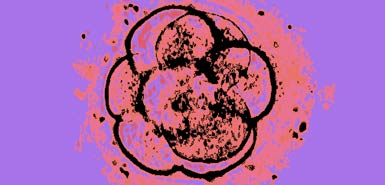
© Times OnlineA false-colour photo of an eight-cell embryo
British scientists will apply this year to start patient trials of an embryonic stem-cell therapy for the commonest cause of blindness.
If approved, the study will be the second of its kind, after US regulators yesterday cleared the first human trial of the powerful master cells. The US decision to approve the trial of a paralysis treatment by the Geron Corporation will open the way for a team at University College London to test a similar therapy for age-related macular degeneration (AMD) on patients.
Pete Coffey, of UCL, who is leading the project, said that the approval of the paralysis trial was "bloody good news".
"It clearly gives a lot of direction to our regulators. It is a precedent of sorts. Our therapy is now very advanced. We are now into the final stages of preclinical work-up. We're already in discussions with the regulatory authorities in the UK, and the fact that Geron's trial is going forward makes the process, I hope, more achievable. We will be making an application later this year, and I would hope we'll go into patient trials some time in 2010 or 2011."
Embryonic stem cells are master cells found in human embryos that give rise to all the specialised tissues in the body. They have exciting medical potential as a source of replacement tissue for treating disease or injury, though their use is controversial because they involve the destruction of human embryos.
The Geron trial, which will begin in the summer, will be the first to test on patients a therapy based on embryonic stem cells. It will investigate the safety and effectiveness of injecting specialised spinal cells grown from the master tissue into people paralysed from the chest down.
Robert Klein, the chairman of the California Institute for Regenerative Medicine, said that the treatment for AMD, which affects up to one in four people aged over 65, was likely to be the second therapy based on embryonic tissue to enter clinical trials.
Professor Coffey has already used embryonic stem cells to grow a type of eye tissue known as retinal pigment epithelium cells, which are destroyed in AMD, leading ultimately to blindness. These have proved effective at reversing the eye damage caused by AMD in animal models, and the team is now finalising the safety data it needs before it can start patient trials. Approval must be granted by three bodies: the Human Tissue Authority, the Medicines and Healthcare products Regulatory Agency and the Gene Therapy Advisory Committee.
The therapy will be tested initially on patients with the dry form of AMD, which affects 90 per cent of sufferers and is incurable. It is expected ultimately to be suitable for the less common wet form as well.
Many scientists have warned against placing too much hope in the technology. Geoff Raisman, of UCL, who is researching an adult stem-cell therapy for spinal cord injuries, said that he was unsure whether Geron's approach would work. "It isn't clear that the mechanism they are targeting is the main cause of paralysis after spinal injury," he said. "There is nothing wrong with doing trials, but it is important not to build up expectations too much."
Stephen Minger, of King's College London, said: "I have concerns about paralysis as the first application. It is not a life-threatening condition: these are young people who have fallen off motorbikes, and they're going to live a long time. If there are any serious side-effects, there could be a negative impact on the field."
Peter Wilderotter, president of the Christopher and Dana Reeve Foundation, said that the late Supermanactor, who was paralysed in a riding accident, would have been excited by the research. "There has been so much speculative and unsubstantiated information about the use of stem cells in spinal cord injury; it is important to study these cells in a rigorously designed clinical trial."
Sean Tipton, a former president of the Coalition for the Advancement of Medical Research, said that he expected President Obama would soon lift the restrictions that George Bush had imposed on stem-cell research.
Reader Comments
to our Newsletter